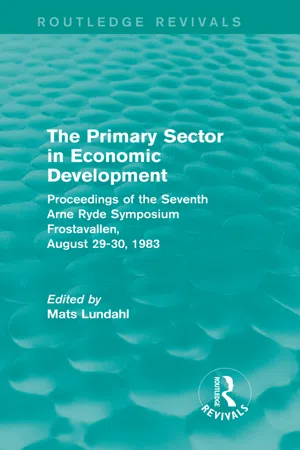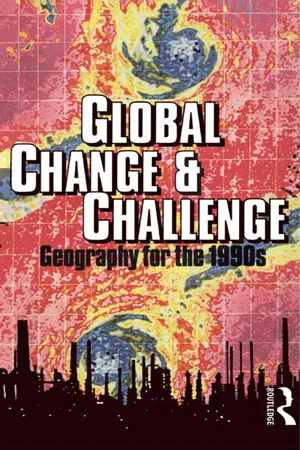Geography
Primary Sector
The primary sector refers to the part of the economy that involves the extraction and production of natural resources. This includes activities such as farming, fishing, mining, and forestry. The primary sector is essential for providing raw materials for other sectors of the economy.
Written by Perlego with AI-assistance
Related key terms
Related key terms
1 of 4
Related key terms
1 of 3
3 Key excerpts on "Primary Sector"
- eBook - ePub
The Primary Sector in Economic Development (Routledge Revivals)
Proceedings of the Seventh Arne Ryde Symposium, Frostavallen, August 29-30 1983
- Mats Lundahl(Author)
- 2015(Publication Date)
- Routledge(Publisher)
1. The Primary Sector and Production
The Four Concepts of the Primary Sector
What the Primary Sector is, what its functions and composition are, is far from clear. There can be at least four concepts or definitions of the Primary Sector. According to the first, ‘narrow’ definition, primary is synonymous with agriculture. The function of the Primary Sector is to produce agricultural consumer goods. In terms of the second ‘intermediate’ definition, the Primary Sector includes all activities needed to produce and deliver agricultural goods to the final consumer. The Primary Sector consists both of goods and services production. Storage, transportation, trade and even those personal services transforming the quantity, time and location dimension of agricultural goods6 are an integral part of it. The second is basically the definition used by Colin Clark.7The third notion of the ‘extended Primary Sector’ includes all rural activities producing agricultural, service and industrial consumer goods needed for the survival of a family. The function of the extended Primary Sector is to produce all consumer goods needed by rural households. As long as they are consumer-oriented and rural, all agricultural, service and industrial activities are part of it.And then there is the fourth and ‘broadest’ notion which includes within the Primary Sector all consumer and capital goods produced by and needed for the survival of rural families. Primary now is synonymous with rural. The primary is a multifunctional, multi-activity, multi-product and multi-service sector.The Four Types of Primary Sector Labour Surplus
This fourfold classification of the Primary Sector is the first step in the process of decomposing its structure, identifying its idiosyncratic features and developing novel development strategies. The usefulness of this classification can be seen by examining the four ‘labour surplus’ concepts that correspond to the four aforementioned notions of the Primary Sector. There exists, first, the well-known and celebrated notion of the ‘agricultural labour surplus’.8 Surplus agricultural labour (narrow primary-sector labour surplus) is that part of the rural labour force that cannot - eBook - ePub
Fair Economics
Nature, money and people beyond neoclassical thinking
- Irene Schoene(Author)
- 2015(Publication Date)
- Green Books(Publisher)
“It is time to abandon dream-world economics and embrace real-world, scientific economics.”Prof. Richard Werner, University ofSouthhampton19. Reciprocal interaction in the three economic sectors
The last chapter concluded with the observation that the principle of reciprocal interaction is in its most basic form practised in the economy, but mostly we are not aware of it. In chapter 7 , we found it hidden in both the private and the public range of nateconomy. Now we will try to show where it is practised, even if a MEANS of exchange is introduced.To do this we will follow a method which was invented by Allan George Barnard Fisher (1895–1976), already cited: Fisher used to separate economic activities into three sectors according to their typical pattern. His idea to divide and categorize the economic sectors is today followed by the offices for statistics all over the world. We will now discuss the different patterns typical for each economic sector:9.1. The Primary Sector: Agricultural goods
Fisher defined the Primary Sector by including everything which is harvested from nature, such as food or wood, for example. This sector contains the products of agriculture, forestry and fishery. So we can state that the Primary Sector represents our direct human interaction with nature.The goods of this sector can only be produced where the natural conditions allow it. Production is location-dependent, depends on the geography as well as the consistency and fertility of the soil, the climate and its location on Earth. Whether it is in the North or in the South will affect it, and whether it takes place near the sea or up in the mountains, for not every seed will germinate under the same conditions as certain plants will not grow, flower and fruit in certain locations.Humans have to rely on nature’s goods on which they live. They are dependent on nature’s production of fresh air and clean water, the first and most basic provisions, not only for themselves, but for every living being on the land or in the air or in the water. Humans cannot manufacture these basic provisions for life, while they are obviously able to spoil or even poison them, if they are not aware of or do not care about the consequences of their activities. Therefore, production in the Primary Sector cannot be decided about autonomously by humans. - eBook - ePub
Global Change and Challenge
Geography for the 1990s
- Robert Bennett, Robert Estall(Authors)
- 2012(Publication Date)
- Routledge(Publisher)
Economic development generally proceeds through a series of stages, in each of which certain kinds of productive activity achieve prominence. This process may be measured by using three broad categories (sectors) of activity: primary, secondary and tertiary. Early stages of economic growth (i.e. in ‘young’ regions) normally find most of the working population in primary activities, especially producing food or basic material requirements like fibre and lumber and some minerals. With the introduction of ideas that increase primary productivity, however, surpluses are created for sale. Incomes rise and more people are able to become engaged in the secondary occupations of manufacturing and construction (chiefly in manufacturing industry) which gradually become the key wealth-producing activity. But manufacturing must be supported (as must improved farming) by better services, especially at first the transport and trading functions. Thus the share of jobs in the Primary Sector steadily declines, while that in manufacturing and related services rises.As labour-saving technologies develop further, productivity in goods production (both primary and secondary) continues to improve. This creates more wealth, and it becomes possible for people to allocate an increasing share of their purchasing power to personal and other services. The services demanded by the goods-producing industries themselves also become more numerous, as in advertising, legal and financial services. As economies advance, therefore, a steadily rising share of the working population finds employment in the tertiary sector. These long-term trends are portrayed in a highly generalised way in Figure 6.1 , which reflects what is known as the ‘sector theory’ of growth.Such change in employment is reflected also, of course, in the contribution made by the different kinds of economic activity to a region's income. At a global level, we can conveniently regard whole countries as ‘regions’, and data available for the years around 1980 (Table 6.1 ) demonstrate the contrasts between old regions (like the UK, USA and West Germany), newly industrialising areas (like Mexico, Greece and Brazil) and poor Third World economies (like Bangladesh, Ethiopia and India). The three major sectors of activity have very different shares in the gross domestic product (GDP) of these countries, and this fact is directly reflected in the income of their populations.Figure 6.1 Shares of jobs at different stages of developmentThe economist Colin Clark, an early worker on sector theory, found a ‘firmly established relationship’ between a region's economic structure and its wealth. High levels of real income per head, he argued, were always associated with a high proportion of the working population engaged in tertiary activity. Low incomes were always associated with a high proportion in the primary. Not everyone accepts the certainty that Clark suggests, but the broad relationship is obvious. The final column of Table 6.1
Index pages curate the most relevant extracts from our library of academic textbooks. They’ve been created using an in-house natural language model (NLM), each adding context and meaning to key research topics.
Explore more topic indexes
Explore more topic indexes
1 of 6
Explore more topic indexes
1 of 4


